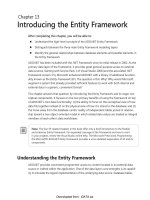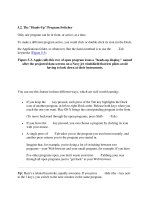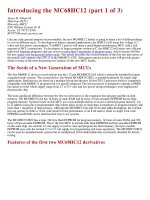Introducing the Google AdSense Program
Bạn đang xem bản rút gọn của tài liệu. Xem và tải ngay bản đầy đủ của tài liệu tại đây (583.23 KB, 14 trang )
Chapter 11
Introducing the Google
AdSense Program
In This Chapter
ᮣ
Evaluating the AdSense program
ᮣ
Meeting AdSense eligibility requirements
ᮣ
Keeping content-sensitive ads relevant to your page
ᮣ
Understanding Google’s revenue-sharing plan
A
dSense is Google’s “other half” of the advertising business. After
making search advertising famous with AdWords, by enabling anyone
to be a global online advertiser, Google introduced a program that enables
anyone to get into the other side of the advertising business by publishing
ads. I say “anyone” reservedly, because Google limits AdSense in certain
ways, whereas AdWords is open to anyone with five dollars and a landing
page. (See Chapter 6.)
This chapter surveys the AdSense program in an introductory fashion, from
the theory of ad syndication to the particular way Google lets Webmasters
publish ads. Chapters 12 and 13 provide more detailed tutorials in applying
for the program and publishing ads on your site. The glossary, at the end of
the book, includes every important AdSense term you need to know.
The Business of Serving Ads
If you follow tech stocks, and especially if you followed them during the
1990s, you know about the importance of ad revenue to online media sites.
Since its inception as a public company, Yahoo!’s quarterly earnings have
been largely about the company’s advertising revenue. Heck, you don’t need
to follow Wall Street to understand the connection between on-screen ads
and Internet revenue — just go to nearly any newspaper site and watch the
pop-ups.
17_571435 ch11.qxd 5/21/04 11:36 PM Page 195
Serving ads is big business across all media. In fact, the magazine industry
isn’t really an editorial industry at all; it’s an advertising industry. We readers
think of pages of content interspersed with ads, which get in the way of arti-
cles and stories. But publishers view it quite differently. To the publisher, ads
are the content. Articles and stories are merely the vehicle which drives
advertising content into the hands of readers. TV? An ad industry. Programs
are excuses for ads. Television is a medium for delivering scheduled adver-
tisements into the home, and that’s the only purpose of its Emmy-Award-
winning dramas and comedies. (An exception is a few cable channels that
earn revenue through subscription fees to cable companies.)
The Internet is more complicated because an online business can actually
transact a product sale, earn a service commission, or take a content sub-
scription directly from a Web page. Nevertheless, advertising started out as
the main business model of the commercial Internet, and it remains one of
the three fundamental revenue plans in the Internet space. Old-media though
it be, advertising drives business online.
Chapter 6 describes how search advertising drives a new-media twist into the
heart of old-school blanket advertising used in television and magazines.
Instead of built-in irrelevancy, search advertising builds in targeted relevancy.
Instead of pushing ads to passive, often sullen recipients, keyword advertis-
ing matches business with consumers who are actively looking for some-
thing, pulling keyword-related content to their screens. And whereas blanket
advertising forces clients to pay for large amounts of irrelevant impressions,
search advertising charges only for clickthroughs to the advertiser.
The advantages are good for everyone — the advertiser, the consumer, and
the search engine serving the ads. The enhanced control and streamlined
costs of keyword-based advertising have rocked the business world and are
poised to change the face of ad-based commerce on the Internet. Google is
really onto something. And with AdSense, you can ride on Google’s coattails.
AdSense enables Webmasters to share Google’s clickthrough revenue derived
from the AdWords program. The little effort that’s required is covered in
the three chapters of this part. AdSense is like a big, unexpected gift to
Webmasters who, until now, have lacked a nearly effortless way to cut their
sliver of the global media pie.
The AdSense Overview
Google AdSense is an extension of Google AdWords. Specifically, the AdSense
program allows non-Google Web sites to display Google advertising (AdWords
ads), and then share the revenue Google charges advertisers when site visi-
tors click through the displayed ads. Clear as mud? Well, look at it this way:
Google ads appear not just on Google but on thousands of sites all over the
Web. These sites serve as syndicators of Google ads. (See Figure 11-1.)
196
Part III: Creating Site Revenue with AdSense
17_571435 ch11.qxd 5/21/04 11:36 PM Page 196
So, what does this seemingly slapdash distribution of Google ads do to the
vaunted relevancy of AdWords and search advertising? On Google, AdWords
ads are associated with keywords and are displayed when somebody searches
on those keywords. When the advertiser does a good job choosing keywords
related to the advertised site or product, relevancy is automatic and chances
are good that the ad is of interest to the Google user. What kind of relevancy
ensues when AdWords ads are displayed on a non-Google site — a site that is,
in most cases, not even a search engine?
Google builds relevancy between ads and their host sites by analyzing the
sites and determining keywords appropriate to them. This task might seem
presumptuous, but remember how much experience and success Google has
in crawling, absorbing, understanding, and indexing Web pages. After all,
Google is in the keyword-matching business and is arguably better at making
those matches than any other company in the world. So if you trust Google to
find Web pages matched to keywords, there’s no problem trusting Google to
display relevant ads on AdSense sites. It’s all about keywords.
Figure 11-1:
AdSense
in action.
This holiday
gift site
publishes
AdWords
for other,
not directly
competitive,
gift sites.
197
Chapter 11: Introducing the Google AdSense Program
17_571435 ch11.qxd 5/21/04 11:36 PM Page 197
Evaluating Your Site’s Eligibility
for AdSense
The AdWords program is available to anyone willing to pay for qualified click-
throughs. Google prevents the display of ads that are not sufficiently relevant
to gain a minimum clickthrough rate, sparing consumers irrelevancy on their
search results pages. Above all, Google protects the consumer search experi-
ence on the Google site. Next on the food chain is the AdWords advertiser,
whom Google strives to protect from poor-quality exposure. For that reason,
Google limits AdSense host sites in certain ways.
To keep the value chain sparkling throughout the AdSense network, Google
establishes the following basic guidelines and terms-of-service rules:
ߜ Vanity sites aren’t allowed. This limitation is perhaps confusing because
some sites start out as personal expressions but add informational, edi-
torial, and service value over time. Google is the only arbiter of these sit-
uations. A 15-year-old who puts up a Web page showing pictures of her
dog probably wouldn’t be allowed to run AdSense ads. An amateur his-
torian who describes Civil War reenactments and collects articles proba-
bly would be allowed to run AdSense ads. AdSense sites don’t have to be
commercial, but they must contain content of some substance. Google
leans toward professional sites, whether they’re operated by individuals
or companies.
198
Part III: Creating Site Revenue with AdSense
The optimization piece of the AdSense puzzle
Relevance is the name of the game at Google,
no matter how you approach it. On the front end,
searchers seek sites relevant to their keywords.
On the back end, advertisers seek relevant
matches between their ads and consumers
using the search engine. When it comes to
AdSense, relevance is likewise crucial to the
content publisher. The Webmaster needs ad
displays relevant to site content. If the ads are
irrelevant, visitors ignore them at best and are
annoyed with them at worst.
Google does its part by applying its relevancy
algorithm to the content site, deducing what it’s
about and serving up targeted ads. My experi-
ence is that Google does a fine job . . . when the
site is well optimized. Here, I’m harking back to
Chapter 4, and pulling the Google business
process full circle. The major elements of build-
ing your business with Google — optimizing
the site, building PageRank, advertising in
AdWords, and syndicating with AdSense — are
tied together by keywords. In this case, pub-
lishers in the AdSense program get the rele-
vancy that they — or, more accurately, their
sites — deserve. Finely optimized pages, with
clear keyword associations built into their tags,
headers, and editorial content, get the most
finely relevant AdWords ads. Relevancy brings
higher clickthrough rates and more revenue.
17_571435 ch11.qxd 5/21/04 11:36 PM Page 198
ߜ Content sites are scrutinized for appropriateness. Like many terms-of-
service rules applying to hosted content, Google’s guidelines prohibit
running AdSense ads on sites that promote illegal behavior, pornogra-
phy, or gambling. In a similar vein, excessive profanity can get an
AdSense site excluded from the program, as can content promoting hate
or violence. Copyright infringement of any sort (music, books, video) is
also out of the question.
ߜ The site must be functional. This is basic optimization. Make sure your
links work and that the site is available to visitors without undue delay
or difficulty. Remember, Google crawls the entire site and can easily dis-
cover dysfunctional navigation.
ߜ You may not reference the displayed ads in your content. Just let the
ads appear. Don’t talk about them, and — most importantly — don’t
advise your visitors to click them. Don’t click the ads yourself. (See a spe-
cial warning about this point in the last paragraph in this section.) Don’t
offer incentives for clicking the ads or plead with visitors to support your
site by clicking any advertising on any page running AdSense ads. You
should probably avoid mentioning any of your advertising throughout
the site. Google is serious about protecting the clickthrough quality on
behalf of its advertisers. Clickthroughs are supposed to represent quali-
fied leads to the advertiser. If you dilute the quality of your site’s click-
throughs, Google will cut you off like a stern bartender at closing time.
ߜ Use only supported languages. Google currently supports sites whose
main language is English, French, German, Italian, Dutch, Portuguese,
Japanese, or Spanish. AdWords advertisers have access to greater lan-
guage support, including Danish, Finnish, and Chinese. But the issue is
not just displaying ads in the language of your site but also crawling and
identifying your site effectively.
ߜ Competing ads are not allowed. Before you advertising veterans get
alarmed, Google means “competing” in a strict sense. You can’t run other
ads derived from search engines, or text ads that look substantially simi-
lar to AdWords ads. You’re certainly permitted to run banner ads (see
Figure 11-2) and, in most cases, simple sponsored links. Affiliate links are
definitely allowed.
To be accepted into the AdSense program, Google must check out your site’s
suitability. Interested parties simply apply online (a short contact form, which
includes your URL for their review). Once accepted, participating sites begin
by simply placing AdSense HTML code on their Web pages. (I describe this in
more detail in the Chapter 12.) AdSense ads start appearing almost immedi-
ately. When that happens, Google is alerted to the presence of a new AdSense
site in the network and reviews the site for eligibility. Sites that fail to qualify
are discontinued soon after they begin hosting ads.
199
Chapter 11: Introducing the Google AdSense Program
17_571435 ch11.qxd 5/21/04 11:36 PM Page 199









